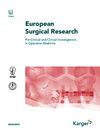PN HPT™ and Striae Albae-Exploratory Interim Analysis of a Randomised Prospective Study
IF 1.9
4区 医学
Q2 SURGERY
引用次数: 0
Abstract
Introduction: The outcomes of striae albae remodelling are currently disappointing. Replenishing the fibroblast pool of nucleotide precursors through passive exposure to Polynucleotides Highly Purified Technology (PN HPT™) facilitates the dermal production of new fibres. The manuscript reports on the outcomes of a prospective study with an intradermal PN HPT™-based medical device. Methods: Intra-subject-controlled randomised real-world study to evaluate the efficacy and safety of a medical device containing 20 mg/mL of PN HPT™ (functional ingredient) intradermal gel as therapy for moderate-to-severe striae albae. Based on a preliminary sample size assessment, the study estimated the need to enrol at least 65 mature albae from 18-to-55-year-old male and female subjects seeking ambulatory treatment (mean age: 34.1 ± 10.65). Up to eight symmetrical striae albae in the target areas (breast, abdomen, buttocks, thighs) per enrolled subject underwent randomisation into the two parallel “PN HPT™ intradermal infiltration” active group and “no-treatment striae albae” intra-subject control group. Actively treated striae albae underwent a four-session intradermal therapy cycle with the PN HPT™ device. Comparative efficacy assessments, performed at the two final evaluation visits by independent evaluators: Width of actively treated and untreated control striae albae (digital calliper). Global Aesthetic Improvement Scale (GAIS) outcomes (by investigators and subjects, respectively; assessments on digital photographic documentation). Width and wrinkling of actively treated and control striae albae (quantitative Antera 3D CS skin imaging technology). Results: The digital-calliper-assessed width for the exploratory sample of the 44 actively treated striae albae (29 control striae) decreased, on average, from 4.6 ± 2.31 at the V1 baseline visit to 2.7 ± 1.42 at V5 (first follow-up visit) one month after the last PN HPT™ intradermal infiltration at V4 (–40.8% vs. baseline, p <0.01). In a subset of 17 striae (7 subjects), the mean digital-calliper-assessed width was still a significant 2.0 ± 0.94 at the final V6 follow-up visit, six months after V1 and three months after V4 (–54.5% vs control striae albae at V6, p <0.05). At the V5 assessment, three months after V1 and one month and a half after V4, investigators and treated subjects reported average GAIS scores of 3.8 ± 0.51 (median, 4.0) and 4.0 ± 0.66 (median, 4.0) out of 5.0 as GAIS maximum score for both. The occasional mild local pain and irritation at the injection site, expected and known in the previous PN HPT™ literature, were of no clinical significance and rapidly transitory. Discussion: PN HPT™ are an innovative option with a solid rationale for treating mature striae albae. The efficacy outcomes of PN HPT™ dermal infiltrations appear noteworthy, with excellent safety and ease of use, confirming the previous results. However, waiting for complete results and confirmation by other controlled studies is prudent.PN HPT™和白纹:一项随机前瞻性研究的探索性中期分析
目前,白纹重塑的结果令人失望。通过被动暴露于多核苷酸高纯化技术(PN HPT™)来补充核苷酸前体的成纤维细胞库,有助于皮肤产生新纤维。该手稿报告了一项基于皮内PN HPT™医疗设备的前瞻性研究的结果。方法:受试者内对照随机现实世界研究,以评估含有20mg /mL PN HPT™(功能成分)皮内凝胶的医疗器械治疗中重度白纹的疗效和安全性。根据初步样本量评估,该研究估计需要招募至少65名年龄在18- 55岁之间寻求门诊治疗的成熟白疮患者(平均年龄:34.1±10.65)。每位入组受试者在目标区域(乳房、腹部、臀部、大腿)最多8个对称白纹被随机分为两个平行的“PN HPT™皮内浸润”活跃组和“无治疗白纹”受试者对照组。积极治疗的白纹用PN HPT™装置进行了4次皮内治疗周期。比较疗效评估,由独立评估人员在两次最终评估访问中进行:积极治疗和未治疗的对照白纹宽度(数字卡尺)。全球审美改善量表(GAIS)结果(分别由研究者和受试者;评估数码摄影文件)。积极处理和控制白纹的宽度和皱纹(定量Antera 3D CS皮肤成像技术)。结果:44个积极治疗的白纹(29个对照纹)的探索性样本的数字卡尺评估宽度平均从V1基线访问时的4.6±2.31下降到V4最后一次PN HPT™皮内浸润一个月后V5(首次随访)时的2.7±1.42(与基线相比-40.8%,p <0.01)。在17条纹(7名受试者)中,在最后一次V6随访时,V1后6个月和V4后3个月,数字卡尺评估的平均宽度仍为2.0±0.94(与V6时对照白纹相比-54.5%,p <0.05)。在V5评估时,即V1后3个月和V4后1个半月,研究者和治疗对象的GAIS平均得分分别为3.8±0.51(中位数,4.0)和4.0±0.66(中位数,4.0),满分为5.0。在以前的PN HPT™文献中预期和已知的注射部位偶尔出现的轻度局部疼痛和刺激,没有临床意义,而且是短暂的。讨论:PN HPT™是一种创新的选择,具有治疗成熟白斑的坚实基础。PN HPT™真皮浸润的疗效结果值得注意,具有良好的安全性和易用性,证实了先前的结果。然而,等待完整的结果和其他对照研究的确认是谨慎的。
本文章由计算机程序翻译,如有差异,请以英文原文为准。
求助全文
约1分钟内获得全文
求助全文
来源期刊
CiteScore
2.30
自引率
6.20%
发文量
31
审稿时长
>12 weeks
期刊介绍:
''European Surgical Research'' features original clinical and experimental papers, condensed reviews of new knowledge relevant to surgical research, and short technical notes serving the information needs of investigators in various fields of operative medicine. Coverage includes surgery, surgical pathophysiology, drug usage, and new surgical techniques. Special consideration is given to information on the use of animal models, physiological and biological methods as well as biophysical measuring and recording systems. The journal is of particular value for workers interested in pathophysiologic concepts, new techniques and in how these can be introduced into clinical work or applied when critical decisions are made concerning the use of new procedures or drugs.

 求助内容:
求助内容: 应助结果提醒方式:
应助结果提醒方式:


